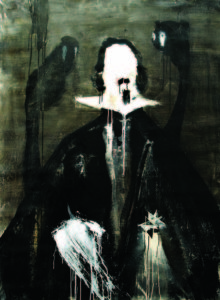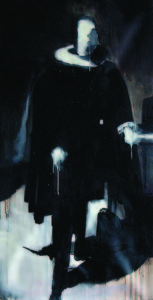From 2005 to 2007, the Berlin-based artist Lars Teichmann created a series of individual and group portraits that excel through a special use of black colour. While the face, the hands, and some very small details of the clothes (like the collar or the sleeves) appear as white areas, the rest of the figure is completely swathed in black. Despite this reduced palette, the artist uses a very dynamic brushstroke and sensitively placed accents to infuse the portrayed with a remarkable vibrancy of their own. The undefined interiors, where the figures are located pick up the dark tones of the portrayed, expanding them in identical or slightly lightened grey or white colour nuances over the canvas.

Let us first take a closer look at a full-body portrait of a man, a subject that Teichmann painted in three very similar variations in 2005. The male figure who supports himself with his left hand on a table is furnished with few attributes. Nevertheless, the collar, the cape, and the posture suffice to call into memory the portraits of the Spanish court painters of the 17th century. A comparison with Velázquez’s pictures of rulers is not far-fetched, because Teichmann repeatedly appropriates specific motifs from Velázquez’s oeuvre in his own paintings. In them, wondrous forms and animals appear that seem reminiscent of the midgets, jesters, and pets of the Spanish court. Male figures with a pale flesh tint, millstone ruff, and the aforementioned black cape and moustache, as were in fashion during the Habsburg regency and frequently illustrated by Velázquez, also dominate Teichmann’s half-body portraits. It shall be mentioned here that in the 17th century in Spain black was considered the colour of the courtliness and exclusiveness.
The ‘Infanta Margarita’ from Velázquez’s Las Meninas, who, with her stiff bearing, her mistrustful gaze, her corset and hooped skirt reinforced with iron and fish bones, long ago passed into the collective memory of Western imagery. Teichmann seems to pay tribute to this with his work (Untitled 3), even though he turns his figure into a side view and transposes the colour spectrum from a positive into a negative form. In the paintings produced in 2008, we are again confronted with ‘men in black’, but they have meanwhile lost their white visages and classic postures and hence also their reference to the Baroque court painters. The outlines of the figure blur more than in the forerunners from 2005-2007, and the backgrounds, released from their black sceneries, gleam in blithesome pastel shades (Refreshing Portrait 1). But Teichmann turns away from this digression, one could also say experimental phase, again after only one year.

In these works from 2009, black becomes the most important bearer of meaning, without pursuing any hermeneutic purpose anymore. References to narrative aspects and subtle pictorial quotations disappear almost entirely; the background and foreground are tone in tone. The works seem figurative without being caught in concretion; they tear empty spaces in the psychology of the viewer, who, as in a film noir, is confronted with stability and fragility, sensuality and cruelty, the comprehensible and the incomprehensible (The Man with the Golden Helmet & 200 Years Later).
To this day, the colour black is still or once again a challenge for many artists, not only because of its symbolic meaning. Black is the absence of colours. Its reception is difficult, because hardly any contrast develops within it. In the 20th century, it becomes the mirror of a basic mood characterised by ambiguity. For the artists of the war generations, a symbol of melancholy and pessimism, for others it becomes an emblem of modernity and the only conceivable means of depicting supposed endpoints. It becomes the expression of a stance towards life situated between the darkly enigmatic and the wrathfully desperate, but also a cipher for a stance between progressive thought, emancipation, non-conformism, and protest.
Teichmann develops pictures whose design asserts that they are figurative, but that, in the process of painting, dissolve in abstraction or, vice versa, whose non-representationality permits the association of forms, faces, or bodies. In these studies of the possibilities and limits of painting, he repeatedly takes recourse to black, as if he acknowledged the arbitrary nature that is culturally attributed to the colour black as the sole emblem for his understanding of art.













